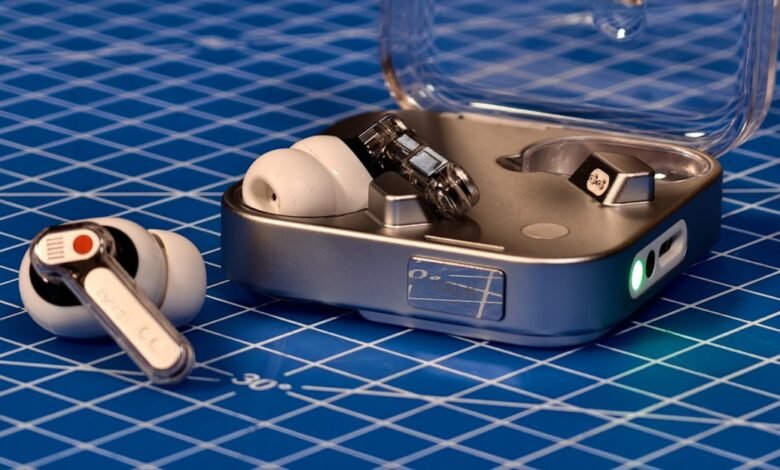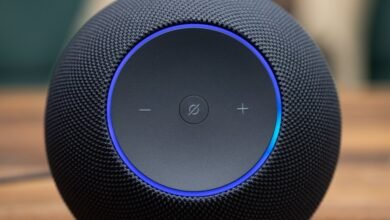Nothing Ear 3 Review: Promising But Not Perfect

▼ Summary
– The Nothing Ear 3 earbuds feature a novel Super Mic system built into the charging case for improved call and voice note audio, though its performance is inconsistent.
– Super Mic requires precise positioning to deliver better sound quality and suffers from compatibility limitations, such as not working with default camera apps on most phones.
– The earbuds offer good audio quality with features like LDAC Hi-Res audio, customizable EQ, and spatial audio, but their noise cancellation is average for the midrange price.
– Battery life provides about 5.5 hours with ANC on and 10 hours with ANC off, with the case offering additional charges, but it is not exceptional.
– Design-wise, the Ear 3 resembles previous models with minor updates like metal accents, and they are competitively priced but may not justify the upgrade over older versions.
Nothing’s Ear 3 earbuds deliver a familiar yet refined experience, building upon the brand’s signature transparent design while introducing the industry-first Super Mic system. This innovative feature integrates microphones directly into the charging case, promising enhanced voice clarity for calls and recordings. While the concept shows genuine potential, its execution reveals both the ambition and growing pains of a company still refining its audio technology.
The $179 Ear 3 represents Nothing’s fourth-generation flagship earbuds, following a somewhat confusing naming sequence that included the Ear 1, Ear 2, and the subsequently released Ear model. The standout addition this time is undoubtedly the Super Mic technology, which positions two microphones within the charging case itself. These are activated through a prominent “TALK” button on the case exterior.
During phone calls, a double press switches audio capture from the earbud microphones to the case microphones, while holding the button enables temporary Super Mic activation. When not on a call, the same button serves as a smart assistant shortcut. The system does require at least one earbud to be active and connected to your phone, as the case cannot establish a direct Bluetooth connection on its own.
Nothing hasn’t published detailed microphone specifications, though the physical size of the case microphones suggests potential audio advantages. The fundamental benefit stems from basic acoustics: a microphone positioned near your mouth naturally captures clearer audio than one located at your ear. This addresses a persistent challenge in wireless earbud design that emerged when manufacturers moved away from wired headsets with inline microphones.
The audio quality through Super Mic proves inconsistent in practice. Testing reveals moments where recording quality reaches levels suitable for content creation, while other instances deliver performance equal to or worse than the standard earbud microphones. The very directionality that provides the theoretical advantage becomes its practical limitation, optimal sound requires precise positioning of the case relative to your mouth. Any deviation in distance, angle, or hand placement causes significant degradation in audio clarity.
Compatibility presents another layer of complexity. Super Mic functions across most communication platforms including native phone apps, WhatsApp, Zoom, and iOS Voice Memos. However, it fails to work with default camera applications on iOS and most Android devices, meaning content creators wanting to use it as a handheld microphone for platform videos must employ third-party applications with manual microphone selection capabilities.
The audio routing through the earbuds introduces noticeable latency when recording video. While minimal enough to avoid issues during voice calls, this delay becomes problematic for video content where audio-visual synchronization matters. The underlying noise cancellation technology for calls performs admirably regardless of microphone source, effectively eliminating background disturbances like construction noise, though sometimes at the cost of slight vocal choppiness.
Active noise cancellation for music listening meets expectations for this price category without exceeding them. Ambient sounds from urban environments, gyms, and public transit consistently penetrate the noise reduction to varying degrees. Those seeking complete auditory isolation will need to consider premium alternatives like the Bose QuietComfort Ultra, which commands a significantly higher price point.
Audio reproduction otherwise satisfies with a comprehensive feature set including LDAC Hi-Res audio support, personalized sound profiles, customizable equalizer options, spatial audio, gaming mode for reduced latency, and multipoint connectivity for two devices simultaneously. The default sound signature emphasizes punchy bass response, though both three-band and eight-band EQ settings provide extensive customization options. Users can save multiple sound profiles, while a dedicated bass enhancement mode offers additional low-frequency emphasis.
Battery performance proves adequate without being exceptional. Nothing claims approximately 5.5 hours with active noise cancellation enabled, extending to 10 hours with ANC disabled, figures that align with real-world testing. The charging case provides roughly three additional charges, totaling about 22 hours with noise cancellation or 38 hours without. Recharging takes slightly over an hour via USB-C connection, or approximately two hours using wireless Qi charging.
Visually, the Ear 3 maintains strong family resemblance to previous models, employing the same blend of white, black, and transparent materials that defined the original Ear 1. The most noticeable aesthetic upgrade comes from metal accents incorporated into both the earbud stems and charging case, improving antenna performance while adding subtle premium tactile qualities. Despite these metallic elements, the overall construction remains predominantly plastic. Both earbuds and case carry IP54 ratings for dust and water resistance, representing a slight downgrade from the previous generation’s IP55-rated case.
Beyond the Super Mic innovation, the Ear 3 offers modest improvements over its predecessor despite the $30 price increase. Slightly enhanced battery life, additional metal components, and new spatial audio support constitute the primary upgrades. Given that last year’s model already delivered excellent value, these incremental changes keep the Ear 3 competitive, though the previous generation might represent better value while still available.
The ultimate decision likely hinges on whether Super Mic technology aligns with your specific needs. While the concept demonstrates genuine innovation, its current implementation feels more like a promising prototype than a fully realized feature that would justify choosing the Ear 3 over established competitors. The true potential of this technology might only be realized with the next iteration, suggesting that the most compelling developments could arrive with future models.
(Source: The Verge)



